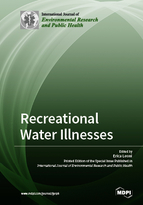Recreational Water Illnesses
A special issue of International Journal of Environmental Research and Public Health (ISSN 1660-4601). This special issue belongs to the section "Environmental Health".
Deadline for manuscript submissions: closed (31 October 2018) | Viewed by 70171
Special Issue Editor
Special Issue Information
Dear Colleagues,
Swimming and other water-based exercises are excellent ways to practice physical activity and to gain health and social benefits. However, recreational water use may expose people to different health risks due to the exposure to chemicals or infectious pathogens. The safety of recreational aquatic environments is affected by numerous variables such as water quality, health conditions of users, the correct functioning of the technological systems used for water treatment.
This Special Issue aims to provide new information about health risks in treated recreational waters (e.g., pools and spas) or untreated waters (e.g., surface water, natural pools, and thermal springs), together with the need to update prevention strategies. We encourage submission of papers concerning the monitoring and control of the chemical and infectious risks associated with recreational waters, the surveillance of infectious diseases in swimming pools and spas, and the study of outbreaks caused by traditional or emerging microorganisms. Papers focused on the adverse health effects due to disinfection by-products (DBPs) in swimming pools are also welcome. Of particular concern is the development of risk control approaches, including the application of effective innovative technologies, the promotion of healthy behaviors, and the design of appropriate polices for surveillance and controls.
Prof. Dr. Erica Leoni
Guest Editor
Manuscript Submission Information
Manuscripts should be submitted online at www.mdpi.com by registering and logging in to this website. Once you are registered, click here to go to the submission form. Manuscripts can be submitted until the deadline. All submissions that pass pre-check are peer-reviewed. Accepted papers will be published continuously in the journal (as soon as accepted) and will be listed together on the special issue website. Research articles, review articles as well as short communications are invited. For planned papers, a title and short abstract (about 100 words) can be sent to the Editorial Office for announcement on this website.
Submitted manuscripts should not have been published previously, nor be under consideration for publication elsewhere (except conference proceedings papers). All manuscripts are thoroughly refereed through a single-blind peer-review process. A guide for authors and other relevant information for submission of manuscripts is available on the Instructions for Authors page. International Journal of Environmental Research and Public Health is an international peer-reviewed open access monthly journal published by MDPI.
Please visit the Instructions for Authors page before submitting a manuscript. The Article Processing Charge (APC) for publication in this open access journal is 2500 CHF (Swiss Francs). Submitted papers should be well formatted and use good English. Authors may use MDPI's English editing service prior to publication or during author revisions.
Keywords
- recreational water
- swimming pools and spas
- thermal springs
- infectious risk
- disinfection by-products
- epidemiological surveillance
- health protection






